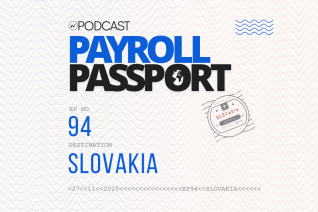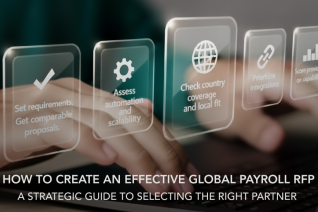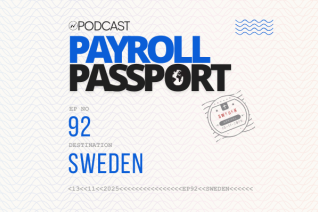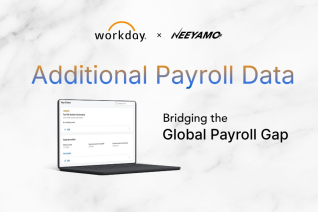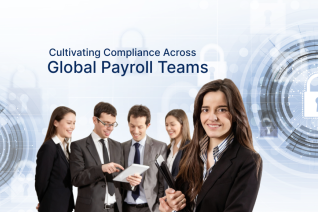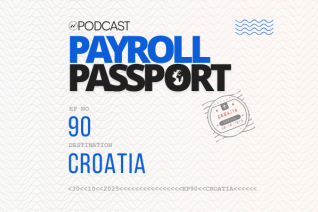What’s New in Global Payroll RFPs: 7 Must‑Ask Questions for Global Companies

If your global payroll RFP still looks like it did in 2020, it’s already obsolete. Global payroll has shifted from manual, cycle‑based processing to AI‑driven, increasingly autonomous operations—and the questions you ask now will decide whether you stay stuck in the past or step into that future.
Across the market, studies show that payroll errors remain common and costly, with each error costing around 291 USD to fix, and accuracy still hovering below 80% in many organizations. At the same time, AI adoption in HR and payroll is accelerating, with research indicating that more than half of organizations are already using or testing AI in these areas, and that AI‑enabled payroll can significantly improve accuracy and reduce manual work. In that context, a traditional RFP that only asks “Can you process payroll in country X?” is no longer enough.
Why traditional payroll RFPs fail now
Most legacy RFPs were written for a different era: a handful of core locations, relatively stable work patterns, and payroll viewed as a back‑office function. They tend to focus on:
- Static country lists and basic SLAs.
- One‑time implementation questions with little focus on continuous improvement.
What they often ignore are the realities of 2025: multi‑country workforces, mobile and remote talent, complex benefits, and ever‑changing regulations. Outdated RFPs typically miss three big risks:
- Fragmented systems: Multiple local vendors, spreadsheets, and manual file transfers that make visibility and standardization almost impossible.
- Hidden compliance exposure: Shadow payroll, cross‑border assignments, and local rule changes that fall between the cracks.
- Employee experience damage: Delayed or incorrect pay leading to stress, lost trust, and even resignations.
A question like “Can you provide monthly payroll reports?” might have been enough a few years ago. Today, you need to ask, “How do you provide real‑time, consolidated global payroll insights with drill‑downs and predictive analytics?”
ALSO READ | Optimizing Long-Tail Payroll: Keys to a Successful and Inclusive Workforce
What an AI‑native, autonomous payroll future looks like
To modernize your RFP, it helps to picture the end state you are aiming for. AI‑native, autonomous global payroll typically includes:
- AI‑driven processing: Automation of validations, anomaly detection, and rule updates that dramatically reduce manual checks and rework.
- Event‑based payroll: Changes like hires, promotions, and terminations trigger updates as they happen, keeping payroll “always ready” instead of relying on last‑minute cycle crunches.
- Intelligent assistance: AI agents that help HR, payroll teams, and employees get answers and perform tasks conversationally instead of navigating complex portals.
- Strategic analytics: Real‑time, consolidated data that informs workforce planning, location strategy, and cost optimization, not just a static pay register.
Neeyamo’s vision of native, intelligent, often autonomous payroll, supported by AI agents like ARIA, fits squarely into this future, and your RFP should explicitly test whether providers can operate at this level over the next three to five years.
Grounding the RFP in your reality
Before listing questions, set the scene in your RFP with a brief, honest snapshot of your current state and ambitions. Include:
- Your footprint: Number of countries, entities, and headcount, plus any especially complex markets.
- Your pain points: Manual work, lack of visibility, compliance anxiety, payroll‑related tickets, or poor employee experience.
- Your vision: Where you want to be: more automation, fewer vendors, stronger analytics, or a more autonomous model.
This context turns your RFP from a generic questionnaire into an invitation for providers to design a solution around your real challenges.
Must‑ask RFP questions for 2025 and beyond
Below are practical, copy‑ready question sets you can drop into your template. They are grouped by theme so that you can skim and use what you need.
1. Coverage and scalability
These questions go beyond “Where do you operate?” and dig into how providers actually support you globally.
- “Describe your global operating model: In how many countries do you provide native or directly managed payroll, and where do you rely on partners?”
- “What is your standard lead time to onboard a new country or legal entity, and what internal and external steps are required?”
- “How do you support different worker types (direct employees, EOR, contractors) on a single platform and in consolidated reporting?”
2. Compliance, risk, and data protection
With regulations tightening and cross‑border work growing, compliance needs more than a checkbox.
- “How do you monitor and implement statutory and regulatory changes across all supported countries, and how quickly are these reflected in production?”
- “What frameworks, certifications, and internal controls do you have for data protection, including encryption, access management, and data residency options?”
- “How do you evidence compliance and auditability to regulators, auditors, and internal risk teams (for example, logs, approvals, and reporting)?”
KNOW MORE | From GDPR to CCPA: Navigating the Global Data Privacy Regulations
3. AI, automation, and autonomous capabilities
This is where you distinguish between vendors that talk about AI and those that actually use it effectively.
- “What percentage of your standard payroll validations are automated today? Which validations still require human intervention? Provide examples.”
- “Which parts of the payroll lifecycle (data collection, validations, approvals, funding, posting) can run autonomously under predefined rules?”
- “Do you provide AI‑powered assistants or agents for HR and employees? Describe common use cases and adoption levels among your customers.”
4. Technology platform and integrations
Global payroll cannot sit in isolation; it must connect cleanly to HR, time, and finance.
- “Is your solution a single global platform or a federation of local systems behind one interface? How do you manage updates and new feature rollouts globally?”
- “Which HCM, time, and ERP systems do you integrate with out of the box, and what APIs are available for custom integrations?”
- “How do you provide real‑time status visibility during the payroll process (for example, dashboards showing data readiness, issues, and approvals)?”
5. Employee and HR experience
Payroll is a big part of how employees experience your brand—especially when something goes wrong.
- “What self‑service capabilities do employees and managers have (web, mobile, chat, voice), and which languages are supported?”
- “How do AI agents or virtual assistants help employees resolve common questions (payslips, tax codes, leave balances) without raising tickets?”
- “Which experience metrics do you track (response times, resolution times, satisfaction scores), and how do you share these with clients?”
6. Analytics and strategic insight
Payroll data is too valuable to be trapped in monthly reports.
- “What global, consolidated analytics are available out of the box, and how frequently is the data refreshed?”
- “Do you offer predictive or prescriptive analytics (for example, forecasting payroll spend, simulating scenarios, or highlighting high‑risk regions)?”
- “How can we integrate payroll data into our existing BI tools, and what support do you provide for data modeling and governance?”
7. Implementation, governance, and commercial model
Technology will only succeed if the implementation, governance, and commercials are set up for long‑term success.
- “Outline your typical multi‑country implementation approach, including phases, approximate timelines, and what resources you expect from our side.”
- “Describe your governance model post‑go‑live—roles, meeting cadence, escalation paths, and the KPIs you typically review with clients.”
- “How does your pricing model scale with employee count, country expansion, and additional modules (for example, AI analytics or experience features)? How do you handle scope or footprint changes mid‑contract?”
To better understand the impact of these questions, consider the following real-world scenario that highlights why they are critical in selecting the right payroll partner.
A multinational technology firm rapidly expanded into five new countries over the course of a year. Without asking whether providers can onboard new countries quickly or support diverse worker types on a unified platform, they faced delayed payroll processing and inconsistent reporting across regions. Missing questions on compliance monitoring led to regulatory fines from untracked local tax changes. Providers using AI-driven validations and real-time payroll analytics helped automate error detection, ensure compliance, and improve employee experience globally. This shows how targeted RFI questions can help companies select partners who scale efficiently and manage risks proactively.
Your next payroll RFP as a strategic lever
Global payroll is at a turning point. On one side are fragmented systems, manual workarounds, and persistent errors that quietly drain money, time, and trust. On the other side are AI‑enabled, increasingly autonomous models that promise higher accuracy, better compliance, and a more seamless experience for HR and employees alike.
The RFP you issue in the next 6–12 months will determine which side you are moving towards. Before you reuse an old template, audit it against the themes and questions in here. Add explicit tests for AI‑native capabilities, autonomous processing, global compliance strength, integrated experiences, and strategic analytics.
That way, you are not just asking, “Who can pay our people?” You are really asking, “Who can help us run payroll as a resilient, intelligent, globally consistent capability for the next decade?” The providers that shine under those questions are the ones that can grow with you, and that is exactly what a modern global payroll RFP should reveal.
For help with your global payroll challenges or to learn more about our solutions, please reach out to Irene Jones at irene.jones@neeyamo.com. Let us partner with you to achieve payroll excellence worldwide.
Latest Resources
Stay informed with latest updates
If you're curious and have a thirst for knowledge pertaining to the HR, payroll, and EOR universe, don't miss out on subscribing to our resources.




